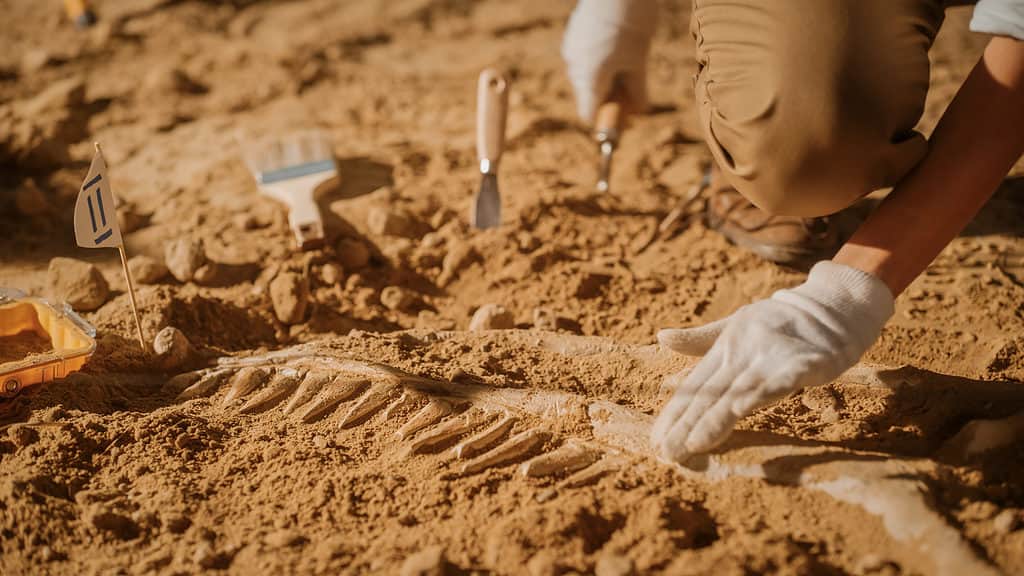
The states of Utah, Montana, Wyoming, and South Dakota are natural reservoirs for dinosaur fossils.
©iStock.com/gorodenkoff
Dinosaurs are amazing creatures that excite children and adults alike. They offer us a glimpse into a time we will never fully understand. Unfortunately, dinosaur bones are extremely difficult to find. Remains are buried under thousands of years of dirt and sedimentary rock.
Paleontologists are lucky to find partial remains or a few bones during an excavation. But there are a lucky few who hit the jackpot and found nearly complete skeletons. The more remains of a single dinosaur found, the better science can analyze the bones and piece together what these animals looked like, and how they behaved and lived.
This article discusses dinosaurs with the most complete skeleton remains.
Haddy the Hadrosaurus

Haddy is so important to New Jersey that is is now the official state dinosaur.
©Audrey.m.horn, CC BY-SA 4.0 <https://creativecommons.org/licenses/by-sa/4.0>, via Wikimedia Commons
Hadrosaurus foulkii, Haddy was a duck-billed dinosaur that lived around 80 million years ago. In October 1858, William Parker Foulke chartered an excavation to the Marl Pits in Haddonfield, New Jersey. At the time, Haddy was the most complete dinosaur skeleton ever found.
Today, she is on display at the Academy of Natural Sciences. Haddy is so important to the scientific community, that the Hadrosaurus is now the official state dinosaur of New Jersey.
Visitors can go to hadrosaurus.com or the Haddonfield main website for updates on her remains.
Scotty the Tyrannosaurus Rex
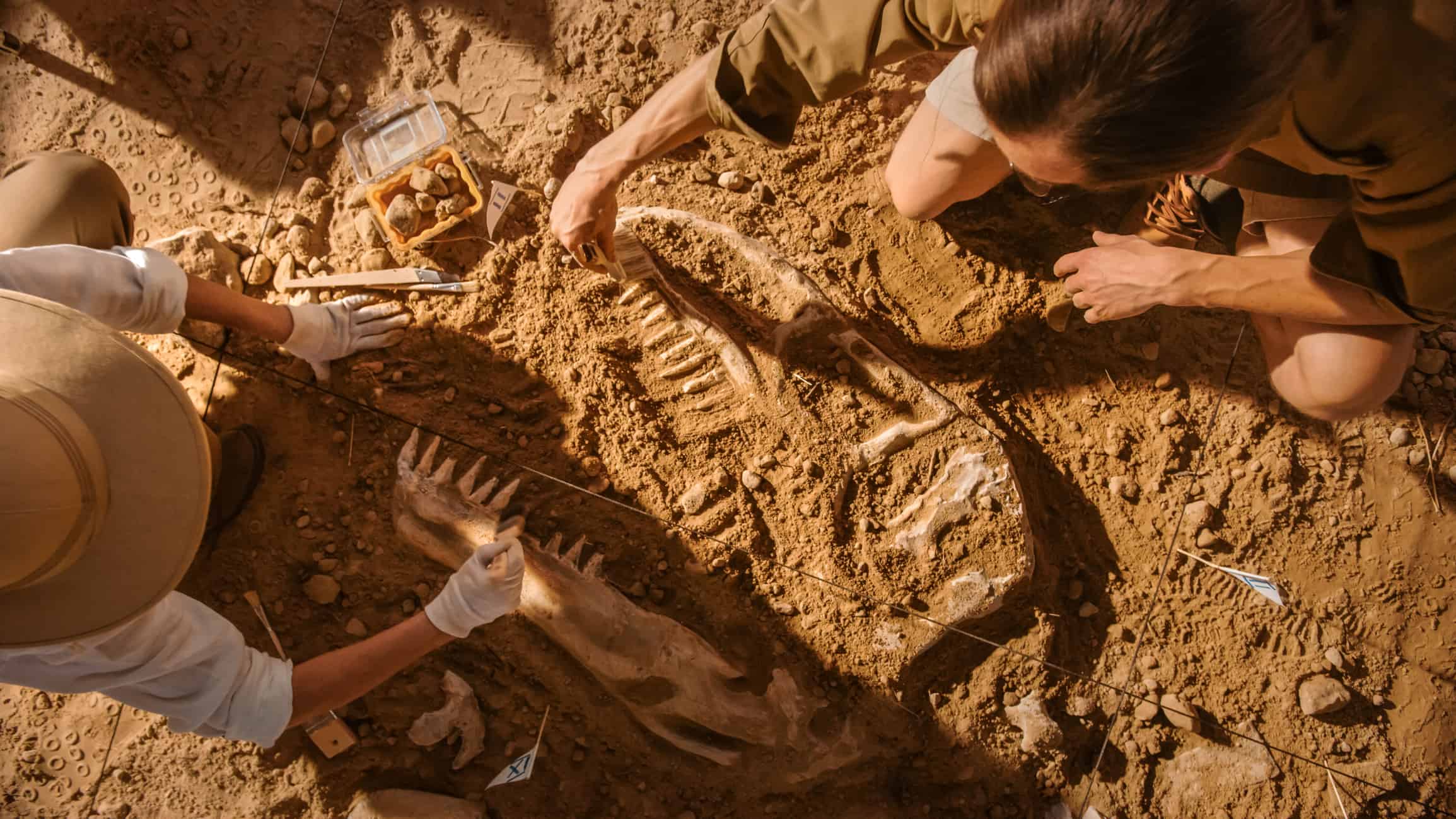
The science community debates whether Sue or Scotty are bigger. They are nearly equal size.
©gorodenkoff/iStock via Getty Images
Catalog number RSM P2523.8, Scotty is a massive Tyrannosaurus rex specimen that has a 65-70% completion rate. He is one of the heaviest and least mature specimens of his type, weighing 8.8 tons and being 23-27 years old upon his death. Scotty likely died from a parasitic infection, common to T-rex at the time.
Robert Gebhardt discovered Scotty in 1991 at Saskatchewan’s Frenchman River Valley, Canada.
Visitors can view the large skeleton at the Royal Saskatchewan Museum. A second mount is on display to provide guests with new updates and findings on dinosaur bones.
Big John the Triceratops

Hell Creek Geological Formation covers Montana, North and South Dakota, and Wyoming.
©Giorez/iStock via Getty Images
Big John is a massive triceratops that caused a lot of controversy with his discovery. This behemoth was 9.8 feet high, 26 feet long, and weighed 1,500 pounds. Nearly 60% of the skeleton was found during the dig, with the skull being 75% complete.
Big John is over 66 million years old. Scientists aren’t sure how he died, but they speculate he fought with another dinosaur and suffered a neck injury that became infected.
Walter W. Stein discovered Big John in May 2014 at Hell Creek Geological Formation in South Dakota. Hell Creek is a common place for archeological digs and paleontological study.
Big John was auctioned off to a private collector for $7.7 million, making him the most expensive triceratops skeleton to date. The sale of dinosaur bones to private collectors concerned the scientific community, but the unnamed owner allowed free study of the fossil.
Today, visitors can find Big John at the Glazer’s Children’s Museum in Tampa, Florida.
Stan the Tyrannosaurus Rex

Small bite marks on T-rex skulls indicate deep battle wounds from rivals or other predators.
©Roger De Marfà/iStock via Getty Images
Catalog number BHI-3033, Stan is a T-rex fossil that is 70% complete. Stan is the second most complete T-rex skeleton ever discovered, next to Trix and Sue (more on them later).
Scientists found enough bones to successfully confirm Stan was a male who lived a long and adventurous life. Stan Sacrison discovered this big boy in 1987 at Hell Creek geological formation in South Dakota.
It is unknown what killed Stan the dinosaur. The bones contained bite marks and wounds, indicating he survived many confrontations, but his size proves he could survive. He likely eventually succumbed to disease due to old age.
Stan’s fossil was bought at an auction for $31.8 million and is currently on display at the Black Hills Institute in Hill City, South Dakota. A deal was made with the Natural History Museum in Abu Dhabi to have Stan as their centerpiece exhibit when the museum is complete.
Trix the Tyrannosaurus Rex
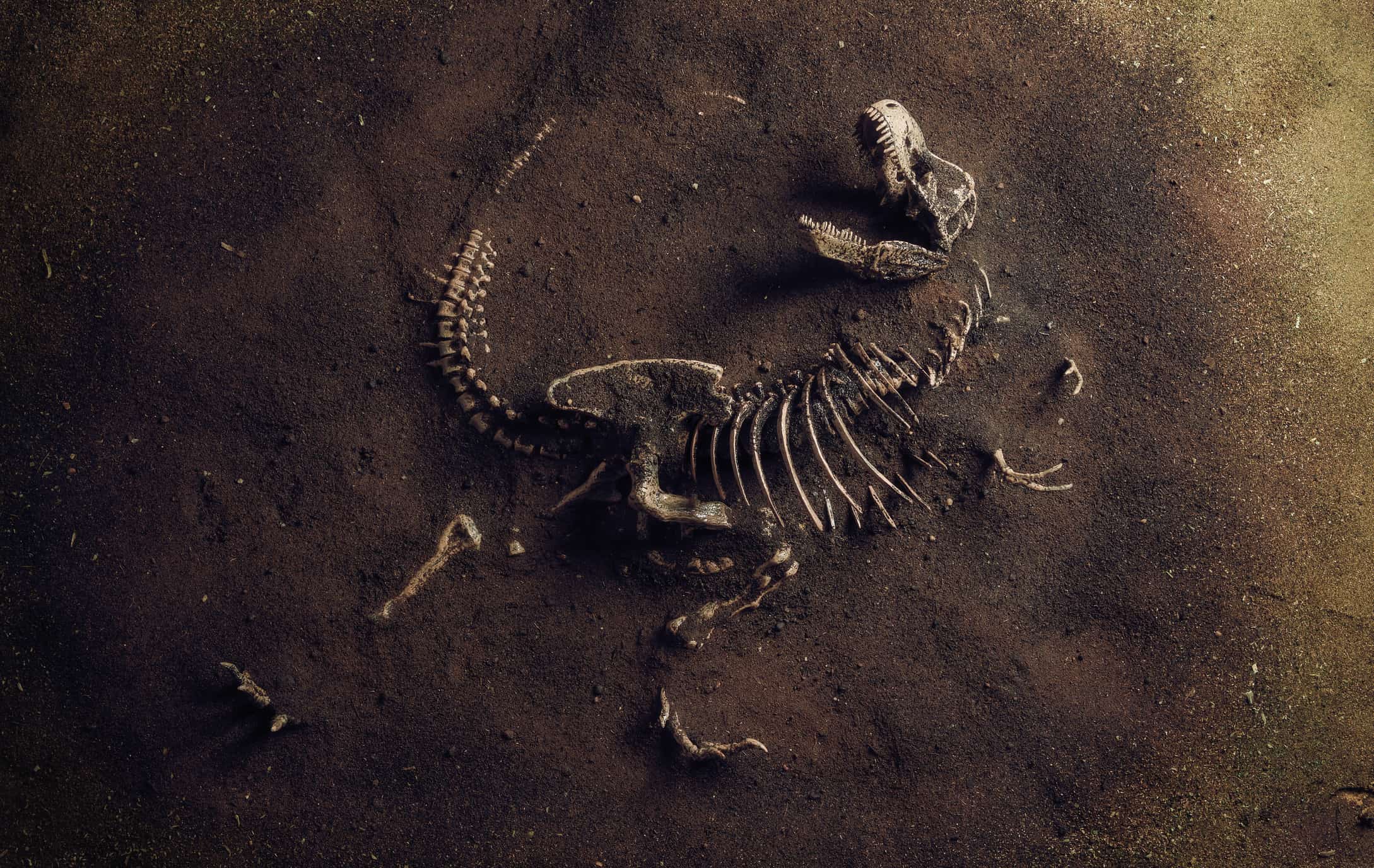
Trix and other Tyrannosaurs died from parasitic infections, similarly to modern day birds.
©Divaneth-Dias/iStock via Getty Images
Catalog number RGM-792, Trix is another T-rex fossil with a high completion rate. Trix has a 75-80% completion rate with the majority of her bones in good condition for analysis. It is unclear if Trix was a female, but the specimen is designated as such.
By carbon dating the bones, scientists suspect she was nearly 30 years old when she died. Trix suffered from several diseases and possible birth defects in her ribs, eventually succumbing to a parasitic infection in the mouth or throat.
Trix was discovered by Blaine and Michele Lunstad of the Naturalis Biodiversity Center in Leiden, Netherlands. The couple found the remains on May 27th, 2013, in Hell Creek Formation in Montana. Blaine and Michele named their find after the Netherlands’s Queen Beatrix.
Horridus the Triceratops

Triceratops have approximately 985 bones in their body.
©herraez/iStock via Getty Images
Triceratops horridus, or Horridus, is one of the largest and most complete specimens of triceratops ever discovered. He was 23 feet long, 6 feet tall, and weighed 2,200 pounds. Nearly 260 bones were uncovered, making Horridus 85% complete. Additionally, his skull is 98% complete.
Horridus lived 67 million years ago and died near or in a river from unknown issues.
This triceratops was discovered in Montana in 2014. His remains are currently on display in the Melbourne Museum in Australia.
Sue the Tyrannosaurus Rex
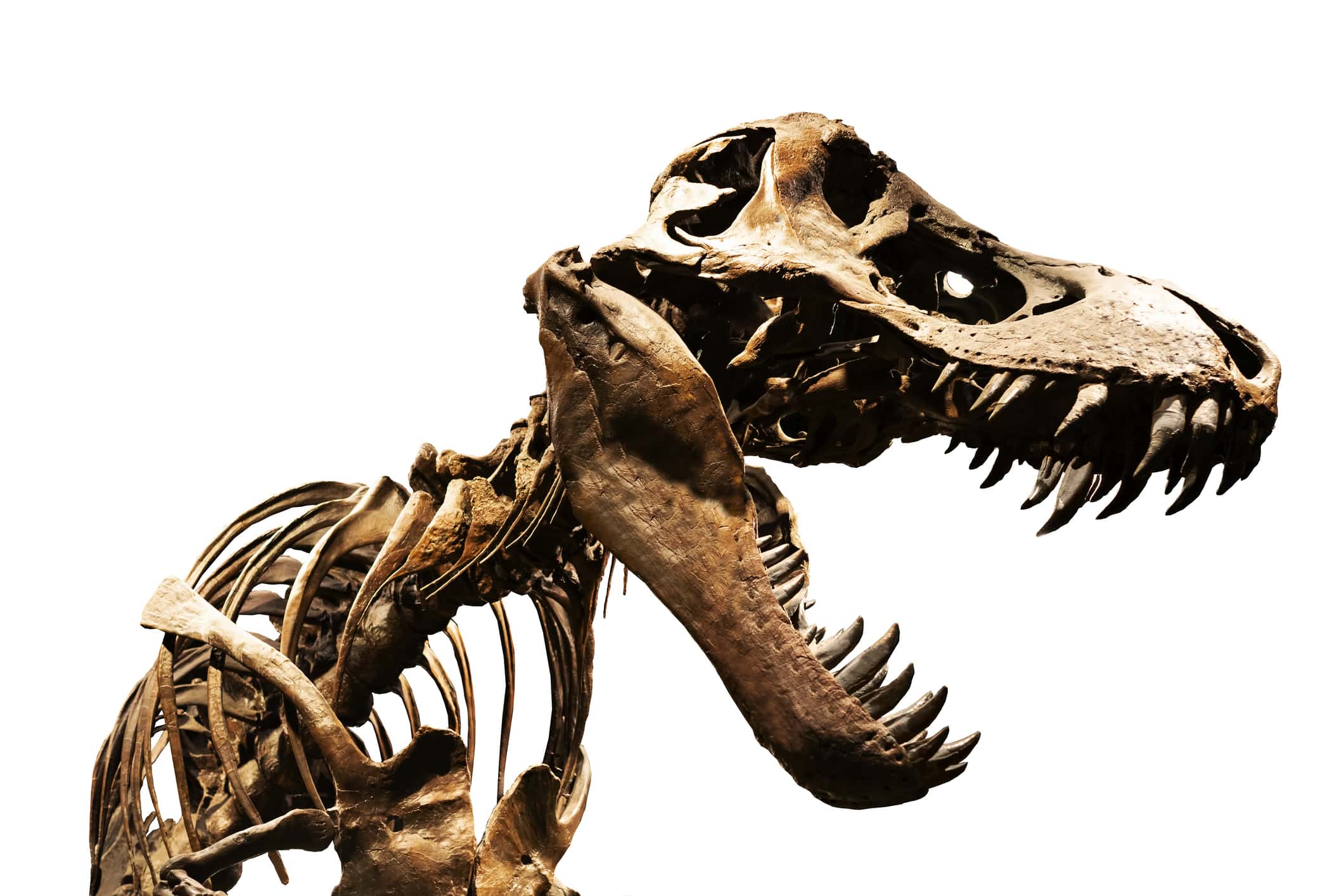
Sue is one of the most important fossil specimens due to her nearly complete skeleton.
©Jerry Ballard/iStock via Getty Images
Catalog number FMNH PR-2081, Sue is the largest and most complete Tyrannosaurus fossils discovered to date. She has a 90% completion rate with 250 bones recovered out of 380 total, making her 42 feet long. Sue lived 67 million years ago and died when she was 28 years old.
Like Trix, Sue survived many battles and broken bones, but most likely died from a parasitic infection targeting the neck or throat. However, Sue’s remains have several bite marks, indicating she might have suffered a fatal bite to the neck.
Sue Henrickson discovered Sue on August 12, 1990. The specimen was named after her for the impressive discovery in the Cheyenne River Indian Reservation in South Dakota.
A large legal debate over Sue’s remains sparked issues in the community. Landowner Maurice Williams allowed members of the Black Hills Institute to perform the excavation for $5,000. The excavation team took the remains, despite Williams claiming they only paid for the excavation rights. Williams won the settlement and sold the bones to the Field Museum for over $8 million.
Dueling Dinosaurs
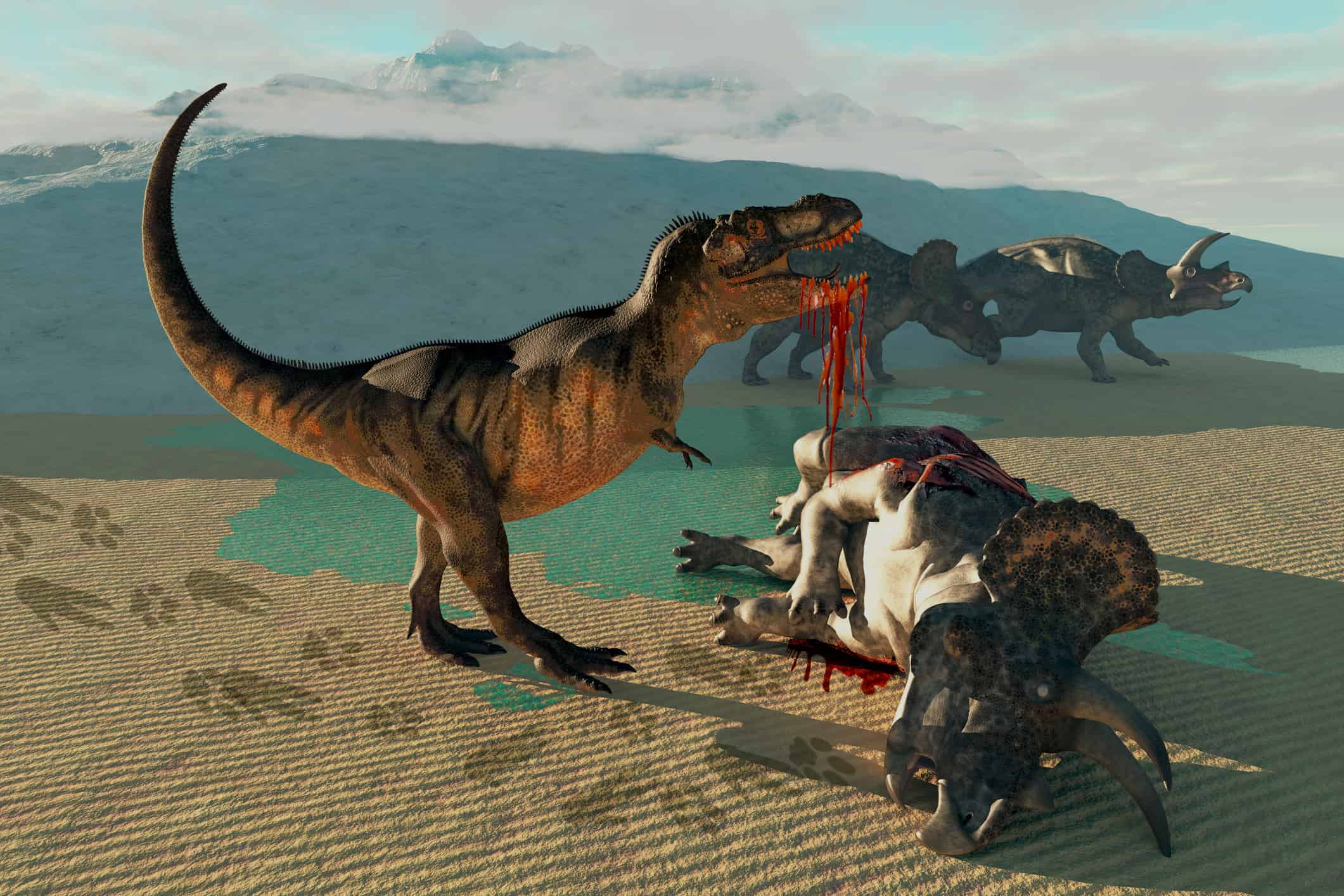
Marks on both skeletons indicate the pair might have died together after a fierce battle.
©CoreyFord/iStock via Getty Images
Finally, the most complete dinosaur fossil skeletons are a combination of two beasts in a climactic showdown. The Dueling Dinosaurs are two skeletons (an adolescent Tyrannosaurus rex and a triceratops) that were trapped in sandstone. Together, the Dueling Dinosaurs have a 98% completion rate.
Their fossils are so well preserved that scientists found impressions of skin, internal organs, and stomach contents in the rock. This discovery could yield answers to how adolescent dinosaurs looked regarding feathers, skin type, and more.
The specimen was found in 2006 by the team of Clayton Phipps, Mark Eatman, and Chad O’Connor. The trio were digging in Hell Creek Formation in Montana for mere minutes when they found the impressive fossil.
Despite the death pose, it is unclear what killed the pair. Their bones indicate damage from teeth and horn marks, indicating they were fighting. Theories suggest they sustained heavy damage from their conflict, each responsible for the death of the other.
The Dueling Dinosaurs are on display in the North Carolina Museum of Natural Sciences.
Summary of Most Complete Dinosaur Skeletons
| Number | Dinosaur Name | Species | Completion Rate |
|---|---|---|---|
| 1 | Haddy | Hadrosaurus – Duck-billed dinosaur | Highly incomplete, but most complete at the time of discovery |
| 2 | Scotty | Tyrannosaurus Rex | 65-70% |
| 3 | Big John | Triceratops | 60% complete body, 75% complete skull |
| 4 | Stan | Tyrannosaurus Rex | 70% |
| 5 | Trix | Tyrannosaurus Rex | 75-80% |
| 6 | Horridus | Triceratops | 85% body, 95% head |
| 7 | Sue | Tyrannosaurus Rex | 90%, 250 of 380 bones recovered |
| 8 | Dueling Dinosaurs | Adolescent Tyrannosaurus Rex vs. Triceratops | 98%, skin impressions, internal stomach contents, proteins |
The photo featured at the top of this post is © superjoseph/iStock via Getty Images
Thank you for reading! Have some feedback for us? Contact the AZ Animals editorial team.






